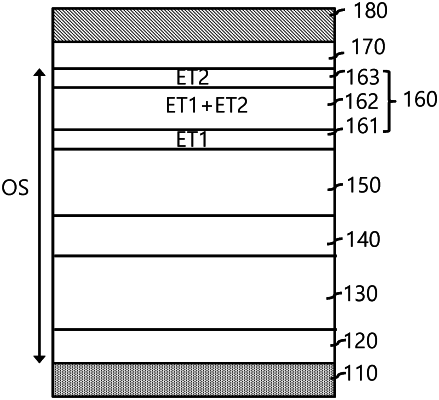| CPC H10K 85/6572 (2023.02) [H10K 50/11 (2023.02); H10K 85/615 (2023.02); H10K 85/626 (2023.02); H10K 85/654 (2023.02); H10K 50/15 (2023.02); H10K 50/166 (2023.02); H10K 50/171 (2023.02); H10K 50/18 (2023.02); H10K 2101/40 (2023.02)] | 12 Claims |

|
1. An organic light emitting device, comprising:
an anode and a cathode opposing each other;
a light emitting layer interposed between the anode and the cathode;
a hole transport layer interposed between the anode and the light emitting layer;
a first electron transport layer directly contacting with the light emitting layer, the first electron transport layer comprising a benzimidazole derivative and a compound of Formula 1;
a second electron transport layer directly contacting with the first transport layer, the second electron transport layer consisting of the compound of Formula 1;
an electron injection layer between the second electron transport layer and the cathode, wherein the second electron transport layer is in contact with a first surface of the electron injection layer, and an inner surface of the cathode is in contact with a second surface of the electron injection layer; and
a capping layer on an outer surface of the cathode,
wherein the compound of Formula 1 has the following structure:
(R1)a-L1-(L2-R2)b Formula 1
wherein:
a and b are each independently 1, 2 or 3;
L1 is, at each occurrence, independently a substituted or unsubstituted divalent, trivalent, or tetravalent arylene group;
L2 is a direct bond or a substituted or unsubstituted arylene group;
R2 is a unsubstituted aryl or an aryl substituted with 1, 2, or 3 cyano substituents; and
R1 is a substituted or unsubstituted heteroaryl group,
wherein the electron transport layer is free of lithium quinolate,
wherein among the electron transport layer, the second electron transport layer is closest to an inner surface of the cathode, and
wherein a light generated between the anode and the cathode is emitted through the cathode and the capping layer.
|